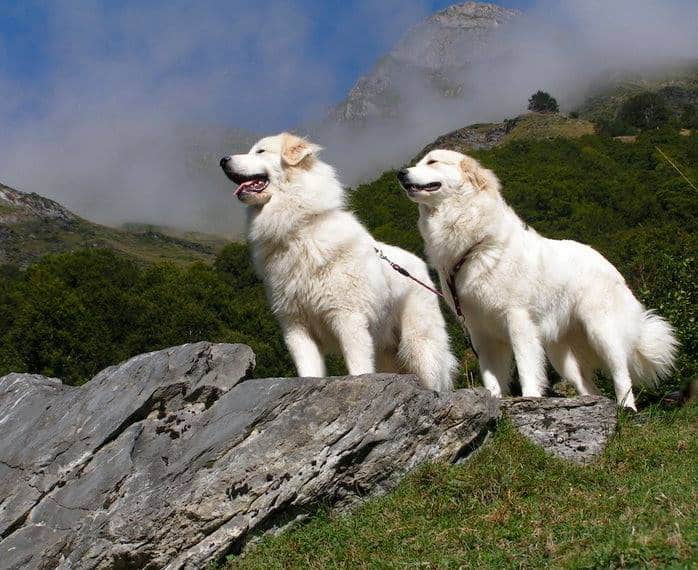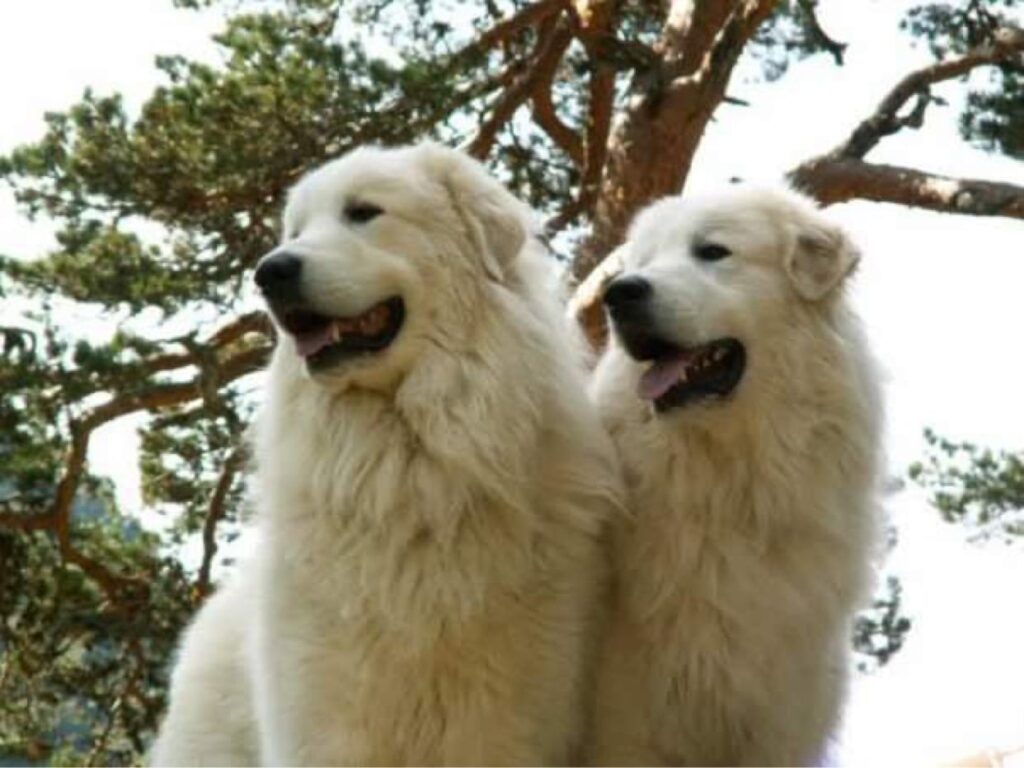
APPEARANCE
The origin of the Pyrenean Mountain Dog, as well as that of the other large guardian dogs of the herds, must be traced back to the dogs of Central Asia, whose closest relative can be identified in the Tibetan Mastiff.
It belongs to the group of molossoids, and this is the main characteristic that distinguishes it from the Maremma Abruzzese Shepherd, with which it however shares very ancient origins.

The Pyrenean Mountain Dog looks like an imposing dog, of great size but, at the same time, never lacking in elegance and a certain agility, unlike other Molosser breeds.
The color of the coat is white, often never absolute but with a color tending towards yellow/orange in particular in the area of the ears; or white with orange or wolf gray (badger) markings on the head, ears, root of the tail, and sometimes on the body.
The male has a withers height between 26,50 and 31,50 inches, but it is not uncommon to find much taller specimens. The weight varies from 110 to 154 lbs. The females, decidedly smaller, measure between 25,50 and 29,50 inches at the withers and reach a weight ranging between 88 and 110 lbs.
The hair, generally thick to shelter the animal from low temperatures, is woolly on the chest and behind the hind legs, forming the so-called “culottes”, while it is longer, smoother and with a “creaky” effect to the touch (hair vitreous) on the back area. It is not uncommon for the hair to grow more in the neck area, so as to form a real mane.
The eyes are almond-shaped, brown/amber in colour, and give the dog a dreamy gaze defined as a “Pyrenean gaze”.
Although it belongs to the molossoid group, the Pyrenean Mountain Dog has, especially in some selections, an elongated muzzle, so much so that it appears like a wolf.
The hind limbs both have the characteristic double spur, which is thought to be deliberately selected to allow greater stability in the snow. However, the unclear functionality of the same would make us think more of a selection useful to differentiate it from other similar breeds, such as the Maremma Abruzzese Shepherd.
The tail, when at rest, is carried pendant, preferably with the tip forming a hook. When the dog is alert, the tail is raised over the back to form a tight circle with only the tip touching the loin; this configuration, according to an ancient expression of the Pyrenean shepherds, is called “arroundera”.
The ears are small, triangular and set at eye level. Carried flat against the head, and higher when the dog is alert.
The pace is never heavy. Despite its size, the dog has large and rapid movements, such as to give it a certain elegance, to the point that the step, often sustained and on pointe, in the eyes of the most romantic could appear that of a dancer entering the stage.
Other more specific characteristics are reported within the standard.
CHARACTER
In terms of character, although it is difficult to ignore the personality of the single specimen and the social conditions in which it finds itself living, it is nevertheless possible to try to identify some character aspects borrowed from the selections that have taken place over the centuries.
It looks like a rustic, robust and solid dog, with a strong temper and self-confidence, so much so as to give it great innate autonomy. For this reason, it is a dog that requires an approach and a level of communication of non-subservience, but, on the contrary, that is treated with great respect, defining, since it was puppies, its precise role within the family and their space; all without coercion, but making sure that the dog is comfortable in its territory.
Used to alone ensure the protection of flocks against predator attacks, selection was based on its aptitudes for guarding and deterring, as well as its attachment to the flock. The main qualities that result are strength and agility, as well as gentleness and attachment to what it protects. This guard dog has a propensity for independence and a sense of initiative which requires a certain amount of authority from its owner.

Precisely because of the protective role that has been reserved for it since ancient times, it cannot be shy or fearful, nor aggressive towards human beings, in particular if they are outside its territory. He must be balanced, more dissuasive than quarrelsome, and intervene only when his discernment, combined with a sense of ownership and the territory, push him to act independently.
Despite the handsome physicality, if well educated, it manages to balance its strength according to the case, proving to be particularly attentive towards children and smaller animals.
Towards unknown dogs it is good to be careful in the approaches; he is an excellent communicator, clear and effective, and if he is a balanced subject he is able to be very kind and delicate, as well as extremely authoritative, without however exceeding aggressiveness.
The predatory motivation is not among its most outstanding characteristics, while guardianship is certainly its scope; which is why he absolutely needs to live in large contexts where he is given the opportunity to satisfy his “guardian spirit”; in fact, it is not uncommon to see it perched on elevated points from which it is possible to keep the space entrusted to it under control.
It is a dog that must be welcomed due to its nature, therefore, that of guardian. It is therefore good to guarantee him a large outdoor space in which to express his nature, without worrying about leaving him in the cold; it is selected to resist very low temperatures, while, on the contrary, it suffers from heat, as well as that of an apartment, for which it is not indicated.
City contexts are also ill-adapted to race. The too many noises and olfactory stimuli of urbanized centers can, not infrequently, perform an action of discomfort towards the dog.
His great autonomy, precisely due to a centuries-old selection that led him to manage situations of guarding and defending the herds on his own, does not require a classic type of training, as can instead happen for other breeds of dogs, such as shepherds for example . It is therefore good to reiterate that the dog’s character development must take place in full respect of his nature, without treating him as a subordinate but as an equal element within his social context, even if well directed, and firmly, to his spaces and to his role.


